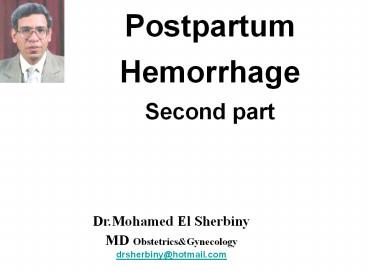Dr.Mohamed El Sherbiny - PowerPoint PPT Presentation
Title:
Dr.Mohamed El Sherbiny
Description:
Postpartum Hemorrhage Second part – PowerPoint PPT presentation
Number of Views:323
Avg rating:3.0/5.0
Title: Dr.Mohamed El Sherbiny
1
Postpartum Hemorrhage Second part
????? ???? ????? ???????? ??????? ???????? ??????
? ??????? ?????? ????? ??????? - ?????? ?????
?????
Dr.Mohamed El Sherbiny MD ObstetricsGynecology
drsherbiny_at_hotmail.com
2
Intractable Postpartum hemorrhage
- About 10 of women will not respond to the
initial management steps and are considered as
intractable PPH.
They are caused mainly by - Uterine atony
- Placenta accretes at CS scar
3
Intractable Postpartum Hemorrhage
- A multi-disciplinary team,
- Hemodynamic Stablization
- Local Control
- Surgery
(SOGC ) Clinical Practice Guidelines 2000 (III)
4
Intractable Postpartum hemorrhage
- The approach to intractable PPH will be
individualized depending on - The clinical situation
- The skill of the operator.
- The technology available.
(SOGC ) Clinical Practice Guidelines 2000 III
5
(No Transcript)
6
(No Transcript)
7
(No Transcript)
8
(No Transcript)
9
(No Transcript)
10
The B-Lynch technique (brace suture) for
intractable hemorrhage
It may be particularly useful because of its
simplicity of application, life saving potential,
relative safety, and its capacity for preserving
the uterus and thus fertility.
The B-Lynch, 1997 B J of Obstet and Gynaecol,
104 372-375
11
B-Lynch technique
12
Hayman Compression Suture
A number 2 Vicryl or Dexon suture on a straight,
blunt needle is used to transfix the uterus from
front to back, just above the reflection of the
bladder and is then tied at the fundus of the
uterus. This can be done as one suture on
each side of the uterus, or more than one suture
if the uterus is particularly broad,
Hayman et al Obst. Gynec. 2002,993502-6
13
(No Transcript)
14
(No Transcript)
15
Hayman Compression Suture
- Vicryl or Dexon are strong and unlikely to
cause external adhesions to the uterus. - It does not appear to be necessary to open the
uterus or avoid crossing the uterine cavity.
Hayman et al Obst. Gynec. 2002,993502-6
16
(No Transcript)
17
Stepwise uterine devascularization for
intractable atonic hemorrhage
This technique entails five successive steps
(using chromic catgut 1 with Mayos needle), if
bleeding is not controlled by one step the next
step is taken until bleeding stops. The
procedure was effective in all 103 (100) cases.
Abdrabbo , 1994, Am J Obstet Gynecol.171694-700
18
(No Transcript)
19
Mov443
20
Mov471
21
22
Stepwise Uterine Devascularization
- Advantages over internal iliac ligation
- Easier dissection.
- Lower complication rates.
- More distal occlusion of arterial supply with
less potential for rebleeding because of
collaterals - High reported rates of success in controlling
haemorrhaging.
(SOGC ) Clinical Practice Guidelines 2000
23
(No Transcript)
24
Placenta accreta, increta and percreta
A placenta previa with previous CS should be
considered of having a morbidly adherent
placenta. Particular attention should be focused
to confirming or excluding this diagnosis using
U/S. When present, senior anaesthetic and
obstetric input are vital in planning the
delivery.
RCOG guidelines Grade B Evidence base.Level
III
25
Placenta accreta
Women who have had 2 or more CS deliveries with
anterior or central placenta previa have nearly a
40 risk of developing placenta accreta. The
patient should be counseled about the likelihood
of hysterectomy and blood transfusion.
ACOG Guideline 2002
26
Placenta previa accreta (Increta or Percreta)
with severe bleeding
1-Low high bilateral uterine vessels ligation
(Stepwise) ,the Best. 2- Longitudinal lateral
sutures 3-Bilateral Internal iliac ligation. 4-
Hysterectomy almost total 5-Tight uterine
packing.
27
(No Transcript)
28
(No Transcript)
29
Bilateral Internal Iliac Artery Ligation
- It was recommended for many decades to control
PPH - It has fallen out of favor because of
- The prolonged operating time
- Technical difficulties
- Inconsistent clinical response.
- High hazard if internal or external iliac veins
are injured.
30
Bilateral Internal Iliac Artery Ligation
- It is indicated mainly for
- Large broad ligament or lateral pelvic hematoma
- Multiple cervical tears.
- L. segment bleeding or atonic pp as a last resort.
It is less effective than Bilateral uterine
artery ligation for atonic postpartum hemorrhage
31
(No Transcript)
32
. After the covering sheath has been opened and
the artery has been carefully freed from the
immediately adjacent veins.
A ligaure is carried beneath the
artery- 3.0 cm distal to the bifurcation- with a
right angle clamp and firmly tied.
Passing the tips of the clamp from lateral to
medial is crucial to prevent injuries to the
underlying veins .
33
(No Transcript)
34
Internal Iliac Artery Ligation
50 failure rate in placenta accreta and uterine
tears
35
Peripartum hysterectomy
- Emergency hysterectomy is the most common
treatment modality when massive postpartum
haemorrhage requires surgical intervention mainly
for - Placenta acretta or percreta ( 50)
- Uterine atony
- Rupture uterus
- CS extension or broad ligament hematoma
Thomas Br J Obstet Gynaecol 1998105127-8.
36
Post Hysterectomy Bleeding
- Diffuse post hysterectomy bleeding may be
controlled by abdominal packing to allow time
for normalization of the womans haemodynamic and
coagulation status. (II-3) - The pack composed of gauze in a sterile plastic
bag brought out through the vagina and placed
under tension. This pack is also known as a
parachute, mushroom, or umbrella pack.
S O G C C L I N I C A L P R AC T I C E G U I D
E L I N E S 2000 II
37
(No Transcript)
38
(No Transcript)































